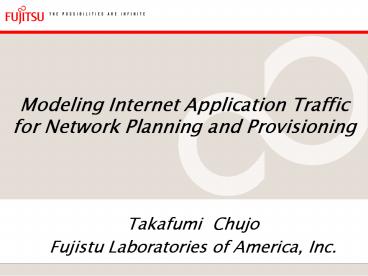Modeling Internet Application Traffic for Network Planning and Provisioning - PowerPoint PPT Presentation
Title:
Modeling Internet Application Traffic for Network Planning and Provisioning
Description:
Modeling Internet Application Traffic for Network Planning and Provisioning Takafumi Chujo Fujistu Laboratories of America, Inc. Traffic mix on converged IP networks ... – PowerPoint PPT presentation
Number of Views:105
Avg rating:3.0/5.0
Title: Modeling Internet Application Traffic for Network Planning and Provisioning
1
Modeling Internet Application Traffic for
Network Planning and Provisioning
- Takafumi Chujo
- Fujistu Laboratories of America, Inc.
2
Traffic mix on converged IP networks
ROBERT B. COHEN, GRID COMPUTING AND THE GROWTH OF
THE INTERNET, GGF 41
3
Next-generation application traffic demands
Core
- Current metro collects traffic from local users
and send it to core and distributes the traffic
from core to the users. - Future metro Supports randomly fluctuating,
bursty traffic with randomly distributed peers.
PoP
Metro
IP Flow Size mean 47kB
Web services
Gaming Grid
Core
Mobile Mesh Network
PoP
IP Flow Size 600MB,5GB
Appliance (PS3)
Metro
4
Future traffic modeling
- Develop understanding of future traffic
properties on core and metro networks - Traffic Growth
- Traffic Mix
- Traffic Pattern (Metro/Core)
- Traffic Characteristics
- Develop understanding of technical and economic
impacts on core and metro network architecture. - Identify new technical issues on network planning
and provisionin.
5
Self-similarity of traffic
W. Willinger, et. al., Self-Smilarity Through
High-Variability Statistical Analysis of
Ethernet LAN Traffic at the Source Level, Apr.
1997
6
Burstiness of traffic
- Characterize property of future Internet traffic
in terms of number of users, access bandwidth,
content size and application
7
Modeling Web traffic Web user distribution
Manchester
Cleveland
Grand Rapids
Albany
Pittsburgh
Hartford
Seattle
Boston
Milwaukee
Allentown
Minneapolis
New York
Sacramento
Detroit
Philadelphia
Des Moines
Chicago
San Francisco
Washington D.C.
Salt Lake City
St. Louis
Kansas City
Denver
Raleigh
Dover
Bakersfield
Greensboro
Knoxville
Los Angeles
Dallas
Atlanta
West Palm Beach
Orlando
Phoenix
Austin
San Diego
Tampa
San Antonio
Houston
Miami
40 Largest US Metropolitan Areas
8
Modeling Web traffic Web server popularity
Manchester
Cleveland
Grand Rapids
Pittsburgh
Albany
Hartford
Seattle
Boston
Milwaukee
Allentown
Minneapolis
New York
Sacramento
Detroit
Philadelphia
Des Moines
Chicago
Washington D.C.
San Francisco
Salt Lake City
Kansas City
St. Louis
Denver
Raleigh
Dover
Bakersfield
Greensboro
Knoxville
Los Angeles
Atlanta
Dallas
West Palm Beach
San Diego
Phoenix
Orlando
Austin
San Antonio
Houston
Tampa
Miami
Based on IRCache logs, Jun. 2002
9
Modeling P2P traffic Control traffic
Control traffic volume 3PB/month
Gnutella network Aug. 2002
10
Modeling P2P traffic P2P user distribution
Gnutella network Aug. 2002
11
Usage daily pattern
Web
P2P
Average 3,000,000
Gnutella network Aug. 2002
12
Content size distribution
Web
P2P
Audio Average 4.5MB
Software Average 34.5MB
Video Average 52.5MB
Gnutella network Aug. 2002
13
Traffic simulation and visualization tool
- Traffic Matrix 3D view
- Traffic Volume 2D time series
- Mean/Peak Ratio 2D time series
14
Test network configuration
Total Population for Ring 5,600,000
Total Population for each Node
15
Web traffic Current scenario
10msec 100msec 1sec
10sec 100sec
- 9-node metro ring, 2.8 million online users,
1.5Mbps access
16
Web traffic Future scenario
10msec 100msec 1sec
10sec 100sec
- 9-node metro ring, 2.8 million online users, 100
Mbps access
17
P2P traffic Current scenario
Window size
10msec 100msec 1sec 10sec
1min 10min
Access BW (max.) 3Mbps/384kbps, File Size
Distribution 10KB-1GB P2P Population 5 of
total population(5,600,000)
18
P2P traffic Future scenario
Window size
10msec 100msec 1sec 10sec
1min 10min
Access BW (max.) 100Mbps/100Mbps, File Size
Distribution 10KB-5GB P2P Population 15 of
total population(5,600,000)
19
Resource provisioning window
- Resource Provision Window
- In a provision window, link capacity is
provisioned at the peak of the traffic - System efficiency system utilization mean to
peak ratio
100Mbps
1 hour
Provision Window(90 efficiency)
50Mbps
10Mbps
Population
1 minute
3Mbps
AccessBandwidth
1 second
1.5Mbps
time
Network Management System
GMPLS
Burst
20
Conclusions
- Internet traffic projection
- P2P accounts for 50 of total Internet traffic
- P2P traffic in particular very large video
objects are dominating the Internet traffic
growth - Application traffic simulations allow accurate
estimation and prediction of inter-metro traffic - Traffic being self-similar ? traffic being bursty
- Actual factors that affect traffic burstiness
Number of users, access bandwidth, content size
and application - Potential for network planning and proactive
bandwidth provisioning - Dynamic resource provisioning to improve system
efficiency for bursty traffic































